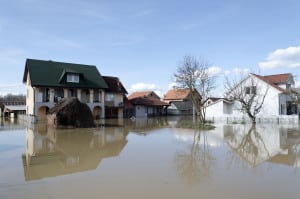The National Flood Insurance Plan is drowning in debt that it may not be able to repay. Inaccurate flood maps, climate change and premiums that don’t accurate reflect risk levels are just a few of the barriers to solvency. The program is due to expire in December and while both advocates and critics say the program needs major changes, there is no consensus on what those changes should be.
Created in 1968, the NFIP has historically teetered around financial stability. Some years it lost money and had to be bailed out with federal funds. Other years it made money and repaid its debts. The 2004-2005 hurricane season changed that.
Claims from hurricanes Katrina, Rita and Wilma overwhelmed the program, requiring it to borrow heavily from the Treasury. Then came Superstorm Sandy in 2012. Today the Federal Emergency Management Agency, which administers the NFIP, owes the Treasury nearly $25 billion (before Hurricanes Harvey and Irma), a debt many say it cannot repay. FEMA has struggled to keep up with interest payments; it only collects about $3.5 billion in premiums annually.
But that’s exactly how it was designed to work, according to Larry Larson, director emeritus and senior policy advisor to the Association of State Floodplain Managers. He is frustrated by Congress’ varied proposals to eliminate the program due to cost while it is functioning as designed.
“When it was created, Congress said they wanted the NFIP to be structured to pay for an average year’s claims and the government would take care of catastrophic claims,” Larson said. “That’s what it does. So who’s to blame? The parent or the child? This Congress just doesn’t like what that Congress did.”
Before the NFIP was created, the federal government paid for disaster relief directly. Today, the NFIP offsets that bill with the premiums it collects. Larson said the Treasury should simply forgive the NFIP’s debt.
Other Options
The NFIP also shouldn’t be the sole source of insurance; the private flood insurance market should be assuming some of the risk as well, though it is too small to handle the entire risk.
“The private market is taking on some of the risk, but the trouble is flood risk modeling is so new and it’s difficult to accurately model a flood, though it’s getting better,” said Joe Rossi of Rogers & Gray Insurance in South Dennis. “Since Sandy the private market has developed stronger. Irma will be a great test of how the private market will work.”
Rossi is chairman of the Massachusetts and Marshfield Coastal Coalitions and sits on the board of directors of the National Flood Determination Association.
The biggest problem with the program is that too few people actually buy flood insurance unless their mortgage lender requires it, Rossi said. Nationwide, about 12 percent of homeowners have flood insurance policies; he thinks that number should be 100 percent.
“Harvey showed you don’t have to be in a high-hazard area to receive flood damage,” Rossi said. “We consider everything a potential flood zone. If you get 50 inches of rain anywhere, you’re going to get flooded. Flood insurance is the best and most effective way to rebuild after a flood. If you’re in a low-risk area you can fully insure a building for $500 to $600. It can be affordable.”
Even before Harvey there was universal agreement that FEMA’s flood maps are outdated and should be improved. The Massachusetts coastline is particularly susceptible to flooding, but it’s not just beach homes that flood.
“On the Cape this summer we had a storm that dropped four inches in an hour and another one that dropped seven inches in four hours,” Rossi said. “If you’re in the middle of the Cape you might think you don’t have a flooding issue, but we’ve seen it happen this year. And 99 percent of the time your homeowners’ insurance policy will not make you whole.”
According to the National Oceanic Atmospheric Association Storm Event Database, in the six months between March 1 and Aug. 31 2017, there were storms during 23 days, 17 of which caused property damage and affected every county in the state.
According to the NFIP website, the average flood insurance policy costs about $700 per year and the average claim it pays is $43,000.
Congress is considering several bills related to NFIP reform. The National Association of Realtors supports H.R. 2874 (21st Century Flood Reform Act); Rossi said he favors S.1368 (S.A.F.E. NFIP Act).
“The House wants to get out of the NFIP altogether,” Rossi said. “We’re always going to need it. It’s not just insurance; it also mandates how buildings can be built in a flood zone. In some areas, there are no state or local building codes. If we get rid of the NFIP, there will be flood zones where there are no building requirements. That would cause a whole ripple effect of consequences.”
The Government Accountability Office advised Congress to consider six areas of reform in an April 2017 report. “To improve NFIP solvency and enhance national resilience to floods, Congress should consider comprehensive reform covering six areas: (1) outstanding debt, (2) premium rates, (3) affordability, (4) consumer participation, (5) barriers to private-sector involvement, and (6) NFIP flood resilience efforts,” the report said.
“The current NFIP administrators have put forward many reforms,” Rossi said. “I am extremely optimistic about its future because Congress understands that there needs to be a private-public partnership. I’m excited to see what’s going to happen in the next few years in the evolution of the NFIP.”




 |
| 


